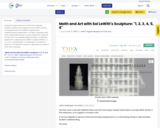
Conditional Remix & Share Permitted
CC BY-NC-SA
Using the Virginia Museum of Fine Arts website, students explore the sculptural work of 20th Century Conceptual artist Sol LeWitt to expand their understanding of geometric concepts, creatively play with mathematical ideas, and be inspired to make art of their own.
The website page provides a scaffolded approach to exploring Sol LeWitt's sculpture titled "1, 2, 3, 4, 5, 6." culminating in a challenge for students to build a 3-D Tinkercad model of a geometry concept of their own choosing.